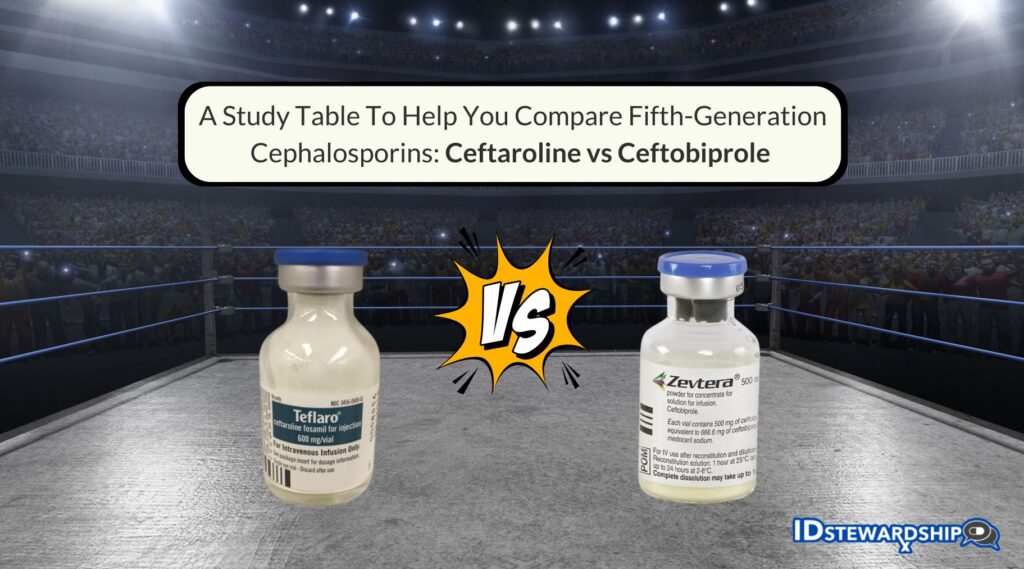This text and table is intended for use as a study tool to assist people learning pharmacotherapy of common bacterial infections. Basic information on antibiotic spectrum of activity, FDA-approved indications, and a study table comparing ceftaroline and ceftobiprole is provided.


Authored by: Natalie Boyer, Pharm.D. Candidate 2025

Mentored by: Christina G. O’Connor, Pharm.D., PharmD, BCPS, BCIDP, AAHIV-M
Article Posted 1 July 2024
Ceftobiprole (Zevtera), FDA-approved at long last!
Ceftobiprole medocaril (Zevtera), an intravenous advanced-generation (or some may say “fifth generation”) cephalosporin prodrug with a wide spectrum of activity is making a long-awaited debut in the United States years after an initial attempt at FDA approval in 2009. In April of 2024, Basilea Pharmaceutica’s ceftobiprole was granted approval by the FDA for three indications: (1) Staphylococcus aureus bacteremia (SAB), (2) community-acquired bacterial pneumonia (CABP), and (3) acute bacterial skin and skin structure infections (ABSSSIs). Given the implications of having another resource available to treat these serious bacterial infections, ceftobiprole was granted Priority Review, Fast Track, and Qualified Infectious Disease Product designations.1
Snapshot of the phase 3 trials that gave ceftobiprole its FDA-approved indications
Staph. aureus bacteremia
In a phase 3 non-inferiority trial looking at the overall success of treating SAB (defined as survival, symptom improvement, Staphylococcus aureus clearance, no new SAB complications, and no use of another antibiotic with potential efficacy), 70% of subjects who received ceftobiprole at 500 mg intravenously (IV) every 6 hours for the first 8 days achieved overall success at 70 days compared to 69% of subjects who received daptomycin 6-10 mg/kg IV daily (with or without aztreonam).2 Gastrointestinal distress was more frequent in the ceftobiprole arm (usually mild nausea), but severe adverse events were more frequent in the daptomycin arm (19% versus 23%, respectively).
Community-acquired bacterial pneumonia
Ceftobiprole was compared to ceftriaxone (with or without linezolid) in a phase 3 trial evaluating clinical cure rates among adults with CABP requiring hospitalization and was found to be non-inferior to its comparator (77% clinical cure with ceftobiprole versus 79% with comparator).3 In another phase 3 trial, ceftobiprole demonstrated similar efficacy to standard-of-care cephalosporins (with or without vancomycin) for the treatment of CABP in participants aged 3 months to 18 years old.4
Acute bacterial skin and skin structure infections
For the treatment of ABSSSIs, ceftobiprole was compared to vancomycin plus aztreonam in a phase 3 trial evaluating early clinical response at 48-72 hours after the start of antibiotics. A lesion reduction of ≥ 20%, survival for ≥ 72 hours, and no additional antibiotics or unplanned surgery were required to be considered an early clinical response. Among the subjects who received ceftobiprole, 91% achieved an early clinical response versus 88% of subjects who received the comparator in the intent-to-treat analysis, meeting non-inferiority.5 Gastrointestinal distress was again the most common adverse effect with ceftobiprole, but adverse effects led to ceftobiprole discontinuation in <2% of patients.
Where does ceftobiprole fit in the world of antibiotics?
Ceftobiprole’s indications for use and spectrum of activity put it among exclusive company. Ceftobiprole joins daptomycin and vancomycin as the only antibiotics with FDA approval to treat Staphylococcus aureus bacteremia. When it comes to the spectrum of activity among cephalosporins, ceftobiprole joins ceftazidime, cefepime, and cefiderocol as the only single agent anti-pseudomonal drugs in their class. Although it should be noted the anti-pseudomonal activity of ceftobiprole is not impressive or very reliable. Pseudomonas is not even listed in the FDA label for the microbiology activity of ceftobiprole. Ceftobiprole, like ceftaroline (Teflaro), is a fifth-generation cephalosporin, which is now comprised of the only two beta-lactams with methicillin-resistant Staphylococcus aureus (MRSA) coverage. However, ceftobiprole stands in a category of its own as the only beta-lactam with activity against both Pseudomonas aeruginosa and MRSA.
With ceftaroline and ceftobiprole being the only MRSA-active cephalosporins and having overlapping FDA-approved indications of CABP and ABSSTI we decided to create a comparison table to help distinguish some important similarities and differences between ceftaroline versus ceftobiprole.
Of note, readers are directed to the links at the end of this post for more details about these therapies.
|
Ceftaroline |
Ceftobiprole |
|
| Brand name |
Teflaro |
Zevtera |
| Generic available |
No |
No |
| Manufacturer |
Allergan |
Basilea Pharmaceutica |
| FDA-approval date |
October 2010 |
April 2024 |
| Drug class |
Fifth-generation cephalosporin |
Fifth-generation cephalosporin |
| Mechanism of action |
Inhibits bacterial cell wall synthesis by binding essential penicillin-binding proteins |
Inhibits bacterial cell wall synthesis by binding essential penicillin-binding proteins |
| Type of killing |
Time-dependent |
Time-dependent |
| Type of activity |
Bactericidal |
Bactericidal |
| MRSA activity |
Yes |
Yes |
| VRSA activity |
Yes |
Yes |
| Gram-negative activity |
Yes |
Yes |
| ESBL activity |
No |
No |
| Pseudomonas activity |
No |
+/- |
| Atypical activity |
No |
No |
| Anaerobic activity |
Minimal |
Minimal |
| FDA-approved for SAB |
No |
Yes (including right-sided infective endocarditis) |
| FDA-approved for ABSSSI |
Yes |
Yes |
| FDA-approved for CABP |
Yes |
Yes (including pediatric use: 3 months to <18 years of age) |
| FDA-approved for UTI |
No |
No |
| FDA-approved for IAI |
No |
No |
| Usual adult dose |
600 mg |
667 mg |
| Infusion time |
1 hour |
2 hours |
| Usual frequency |
Every 12 hours* |
Every 6-8 hours |
| Half-life |
2.66 hours |
3.3 hours |
| Main elimination route |
Renal |
Renal |
| Oral formulation |
No |
No |
| Injectable formulation |
Yes |
Yes |
| Renal adjustment |
Yes (CrCl < 50 mL/min) |
Yes (CrCl < 50 mL/min) |
| Hepatic adjustment |
No |
No |
| Major drug interactions |
No |
No |
| Notable toxicities |
Nausea, vomiting, diarrhea, rash |
Nausea, vomiting, diarrhea, anemia, hypokalemia, hepatic enzyme elevations |
| FDA boxed warnings |
None |
None |
| Precautions |
Hypersensitivity; C. difficile diarrhea; neurological reactions; Direct Coomb’s test seroconversion |
Hypersensitivity; C. difficile diarrhea; seizures and other CNS reactions; increase in mortality in patients with ventilator-associated bacterial pneumonia (VABP) – not approved for VABP; |
| Routine labs |
CBC, renal function |
CBC, renal function |
| Cost |
Expensive |
Expensive |
*Sometimes given every 8 hours off-label with vancomycin or daptomycin in combination for MRSA bacteremia, sometimes referred to as “daptaroline” or “vanctaroline”
Abbreviations: ABSSSI = acute bacterial skin and skin structure infection; CABP = community-acquired bacterial pneumonia; CBC = complete blood count; CrCl = creatinine clearance; ESBL = extended-spectrum beta-lactamase; FDA = Food and Drug Administration; IAI = intraabdominal infection; MRSA = methicillin-resistant Staphylococcus aureus; SAB = Staphylococcus aureus bacteremia; UTI = urinary tract infection; VRSA = vancomycin-resistant Staphylococcus aureus
For further information, see the Full Prescribing Information for ceftaroline and ceftobiprole
Closing Thoughts
With the recent approvals of powerful antibiotics such as ceftobiprole, there is no better time to remind ourselves of the role we can play in antimicrobial stewardship. Use wisely, use only when indicated.
Recommended Readings
1. FDA News Release: FDA Approves New Antibiotic for Three Different Uses. U.S. FDA. 2024.
RECOMMENDED TO YOU









